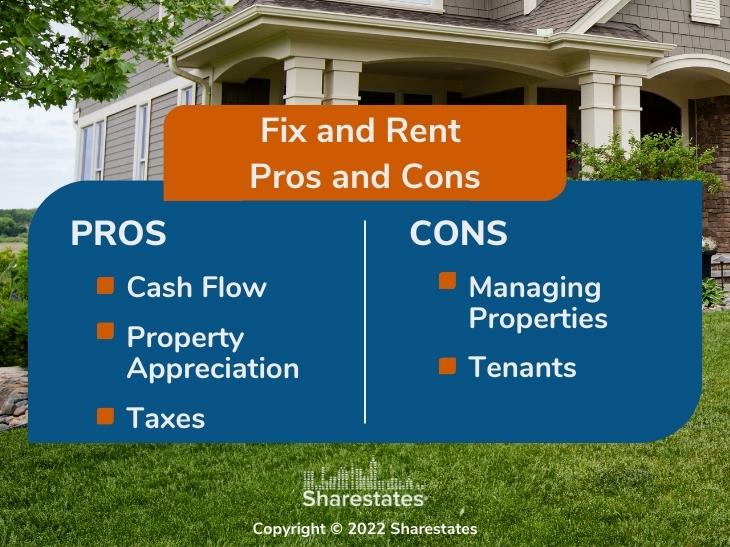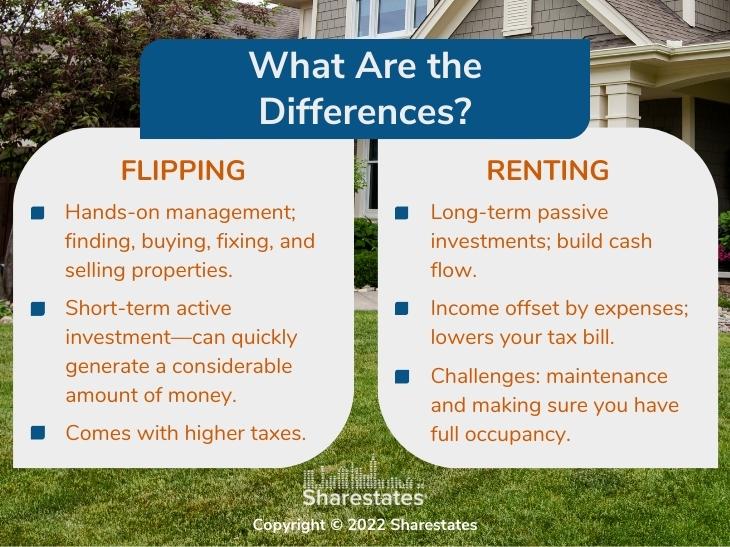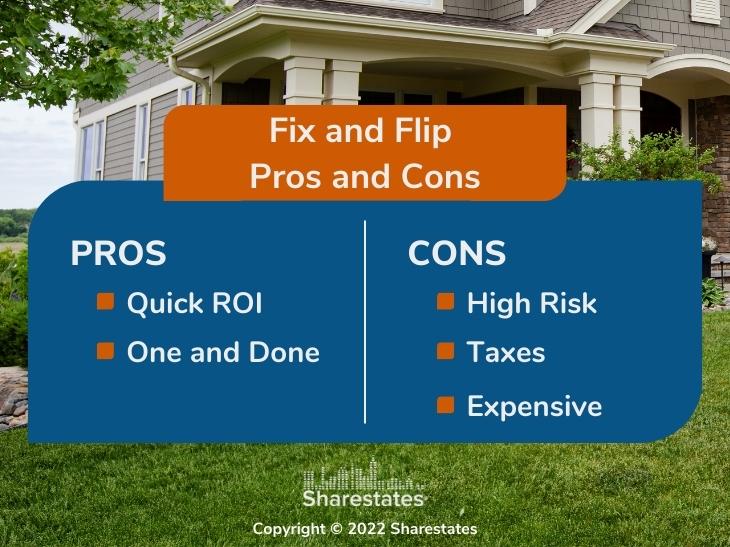Fixing and either flipping or renting are two distinctly different approaches to making money in real estate. Home flips in 2021 averaged a gross profit of $65,000 for a 31% ROI. Average annual rental revenue varies significantly by location; overall residential rental properties in the U.S. have an average return of slightly over 10%.
This article examines the differences between fixing and flipping vs. renting, digging into the pros and the cons.
What Are the Differences?
Flipping requires hands-on management, finding, buying, fixing, and selling properties. With renting, you’re finding, buying, fixing, and renting properties. As the rental landlord, you’ll still be involved with the property in finding tenants, providing maintenance, and collecting rent.
From an investment perspective, flipping homes is a short-term active investment that can quickly generate a considerable amount of money. That also comes with increased taxes, chiefly capital gains tax. Plus, flipping happens within the ever-changing real estate market, whether changing mortgage rates or fluctuating home prices.
Rental properties are long-term passive investments that build cash flow. That income is offset somewhat by ongoing expenses. But that also lowers your income tax bill. The challenges are maintenance and making sure you have full occupancy. An empty rental property isn’t making any money.
Fix and Flip Pros and Cons
You now have a good idea of the differences between active and passive real estate investment. Here are the key pros and cons that you’ll need to consider when fixing and flipping a property.
- Pro—Quick ROI. House flipping provides an excellent return on investment in a few months and seldom longer than a year. It’s buying, fixing, and selling.
- Pro—One and Done. Along with the quick timeframe is the fact that your project is completed quickly, and you’re moving on to the next project. That helps a great deal with the risk associated with fixing and flipping.
- Con—High Risk. Real estate markets change quickly, exposing your investment to a great deal of risk. You could end up with a lower home value than you paid if the neighborhood declines or mortgage rates rise, leaving behind the type of buyers interested in your property. There are also the project risks of taking too long or becoming too expensive with newly discovered repairs.
- Con—Expensive. There are several expenses involved in flipping a house. That includes financing, insurance, real estate commission and title fees, repair work, and utilities. Your plan will need to consider all this before the purchase to ensure the project provides a reasonable return on investment.
- Con—Taxes. If the purchase, fix, and sale is completed within a year, the profits will be taxed as regular income, from 25% to as high as 40%. If it’s longer than a year, it will be a capital gains tax, which is lower at 15% to 20%.
Fix and Rent Pros and Cons
There are similar pros and cons to fixing and renting a property.
- Pro—Cash Flow. With a rental property, you have an ongoing monthly income. That steady cash flow isn’t as lucrative as flipping, but it keeps giving long after you’ve made the purchase.
- Pro—Property Appreciation. Over time, the property’s value increases due to inflation or market conditions where available homes are in short supply. That typically means the longer you hold the property, the higher its value. Rental income coupled with property appreciation increases your wealth.
- Pro—Taxes. Since rental income is long-term, the tax rate on profits is 15% to 20%. Plus, you can deduct maintenance and other related expenses along with the depreciation of the property.
- Con—Managing Properties. Unlike the “one and done” aspect of flipping properties, a rental typically requires repairs before renting, followed by regular maintenance. That maintenance can be mitigated to a certain extent by doing a complete remodel before renting. But even with that approach, you’ll still be taking care of the overflowing toilet and any household challenges.
- Con—Tenants. Some of those challenges are caused by tenants. While it can be tough to work with tenants, it’s impossible to make money without them. So the risks with rental properties are a high vacancy rate or tenants that don’t pay their rent.

So, there are pros and cons with either approach to real estate investment. You can also combine the two options by fixing and flipping a property to generate the money to purchase a rental property.
Either approach requires financing. To help you consider the options, we’ve provided a brief guide to private real estate loans. It includes details on what you need to do to secure a private loan. You can also review our article on the pros and cons of private real estate loans.
We hope this review has helped provide insight into fixing and flipping vs. fixing and renting properties. To find out about funding for your business through Sharestates, click here.




